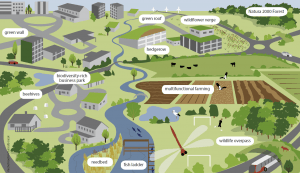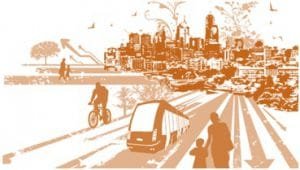
SUSTAINABILITY AND SUSTAINABLE DEVELOPMENT-Assistant Professor: Jaynandhini, M.Arch
The term “sustainability” and “sustainable development” have been introduced over the years, but the most commonly cited one comes from the United Nations report “Our Common Future,” known as the Brundtland Report. That report defines “sustainable development” as development that “meets the needs of the present without compromising the ability of future generations to meet their own needs.”
Sustainable development is also often defined as development that promotes the “threeE’s”: Environment, Economy, and Equity. The chart below shows the theoretical relationship among these three.
 Fig 1: Theoretical relationship of sustainability
Fig 1: Theoretical relationship of sustainability
(Source: https://www.rit.edu/kgcoe/ise/sustainability)
Sustainable Community Development Sustainable communities are:
Environmentally Sound: Decision-making focuses on reducing the impacts of population growth and development on natural resources and the environment.
Economically Productive: Community members make local capital investments that will sustain local human and natural resources and yield adequate financial returns to those investments.
Socially Just: Equitable access to resources and decision-making processes foster the distribution of foods and benefits across all sectors to the community.
THREE PREREQUISITES OF A SUSTAINABLE GREENFIELD PLANNING
The three elements that follow introduce the critical prerequisites for sprawl-free sustainable Greenfield development.
- Green Infrastructure – A green infrastructure—preserved watersheds and other natural and cultural resources in a connected open-space system—can also make “hard” infrastructure such as rights-of-way, utilities, and recreation more land-friendly and cost-effective.


- Mobility and Access – For residents, traffic may be the worst thing about sprawl. An integrated, multimodal transportation network should reduce automobile dependence by as much as 25 percent. Local and regional Greenfield planning can enable smarter use of car trips and create alternatives, from pedestrian accessible shopping and schools to bikeways, carpools, vanpools, and future bus and rail/tram connections.


- Liveability and Lifestyle Choices – A third, more complex priority is providing a range of life and lifestyle choices. Over the past 20 years, the urban household has dramatically shifted; now, only 25 percent of homebuyers are the traditional two-parent/two-child household. This change in demographics requires a diverse mix of housing types, sizes, and prices within regions and communities (and, where possible, within neighbourhoods). Furthermore the lifestyle options should include the local and regional employment.
日本藤素
CONCLUSION
Thus the Planned communities provide a very good vehicle for achieving all these objectives and more where these communities have greater potential to conserve large tracts of open space that are biologically significant. They can help construct financial mechanisms to support a variety of housing types and price points also they can mix uses over their development life, bringing vitality, walk ability, and a sense of community.

0 comments